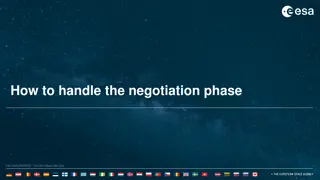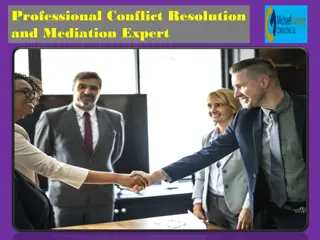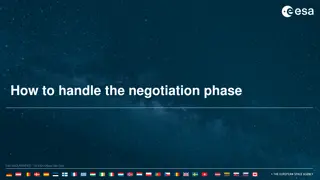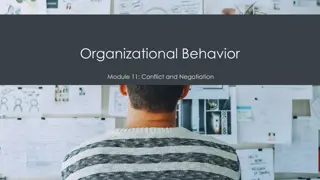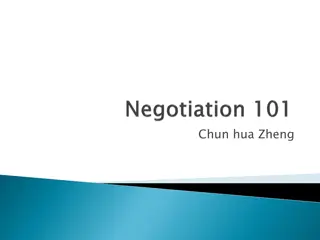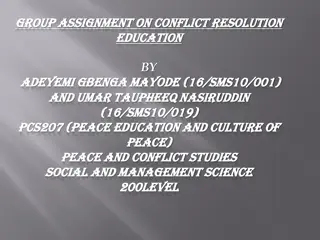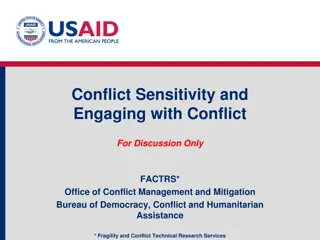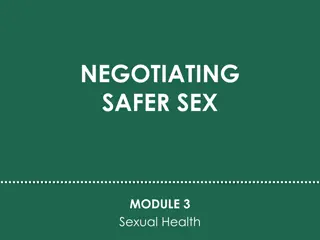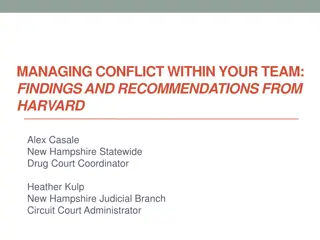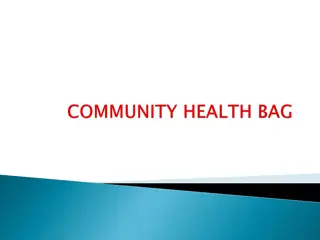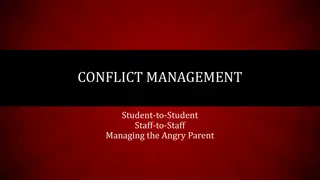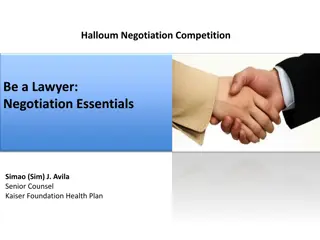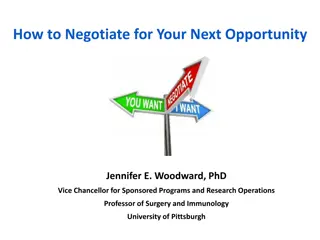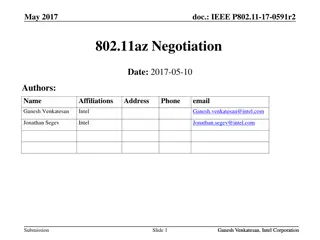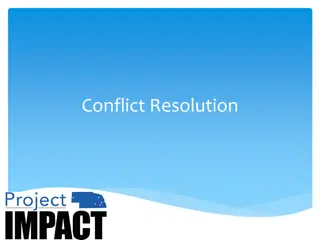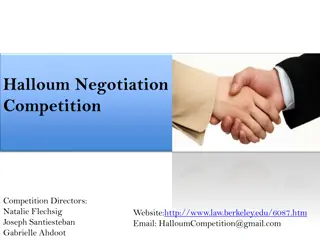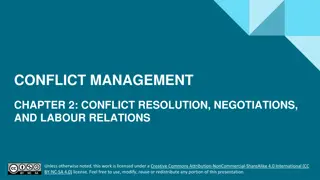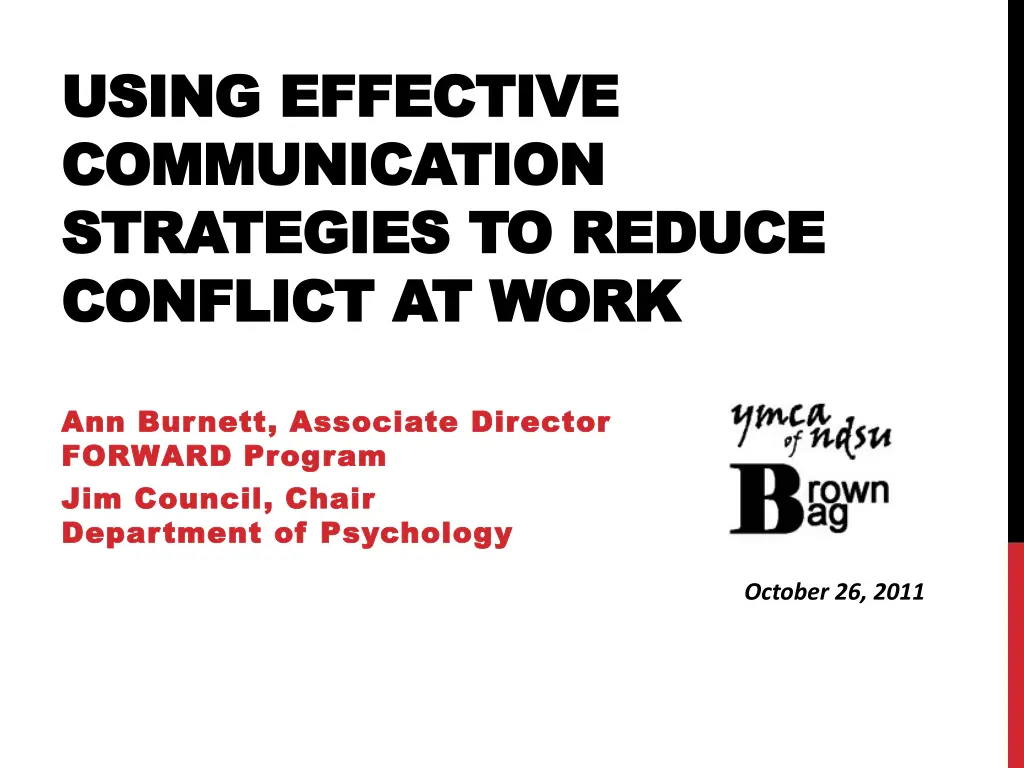
Effective Communication Strategies for Conflict Reduction at Work
Learn about common causes of conflict at work, how conflict is experienced, different conflict styles, and a case study on handling conflict situations. This informative resource provides insights and strategies to effectively reduce conflict in the workplace.
Uploaded on | 1 Views
Download Presentation

Please find below an Image/Link to download the presentation.
The content on the website is provided AS IS for your information and personal use only. It may not be sold, licensed, or shared on other websites without obtaining consent from the author. If you encounter any issues during the download, it is possible that the publisher has removed the file from their server.
You are allowed to download the files provided on this website for personal or commercial use, subject to the condition that they are used lawfully. All files are the property of their respective owners.
The content on the website is provided AS IS for your information and personal use only. It may not be sold, licensed, or shared on other websites without obtaining consent from the author.
E N D
Presentation Transcript
USING EFFECTIVE USING EFFECTIVE COMMUNICATION COMMUNICATION STRATEGIES TO REDUCE STRATEGIES TO REDUCE CONFLICT AT CONFLICT AT WORK WORK Ann Burnett, Associate Director Ann Burnett, Associate Director FORWARD Program FORWARD Program Jim Council, Chair Jim Council, Chair Department of Psychology Department of Psychology October 26, 2011
CONFLICT CONFLICT An interaction in which one party perceives another as interfering with the attainment of an important goal Different from an argument or disagreement Precipitating event may not be the actual root cause University personnel spend a lot of their time dealing with conflicts! Conflict can be expensive money, time, energy Former Provost Schnell estimates that NDSU has spent over $400K on litigation in past decade just one piece of total costs
COMMON CAUSES OF COMMON CAUSES OF DEPARTMENTAL CONFLICT DEPARTMENTAL CONFLICT Resource allocation Ego and ranking Student grievances Faculty-staff misunderstandings Change Multiple relationships / blurred boundaries Other examples?
HOW WE EXPERIENCE CONFLICT Homeostasis state of balance Triggers pull you out of homeostasis Your behavior, feelings, thought patterns during conflict Their behavior, feelings, thought patterns during conflict What are your triggers? What do you do with this knowledge? Self-empowerment Recognition of the other person
CONFLICT STYLES High Competition win Collaboration win-win Problem - focused Compromise okay-okay Avoidance denial Accommodation the fixer Low High Relationship - focused
CASE STUDY 1: HOW COULD THIS SITUATION BE HANDLED? A department Head gives her administrative assistant (AA) a report to complete for an important meeting scheduled for today. When the Head gets in, she sees the report on her AA s desk in a pile of other work, obviously undone. Her meeting is coming up in a few hours, and her AA tells her he has to get to the dentist in a couple of hours for an emergency appointment due to a cracked tooth. Competition, Accommodation, Avoidance, Compromise, or Collaboration?
MANAGING CONFLICTS AT MANAGING CONFLICTS AT WORK WORK Be Proactive Be sensitive to developing situations that could lead to conflict Communicate with faculty, staff, and students Don t be afraid to voice concerns about potential conflict situations Avoidance is not the answer Deal with minor conflicts before they become major ones Parties harden into adversarial positions as conflicts escalate
HOW TO FIGHT CLEAN (VS. DIRTY) Dirty Clean Kitchen sinking One subject at a time Hitting below the belt Set ground rules Benedict Arnold Don t pull in others Character analysis Stick to topic Cross-complain Establish equality Pull rank Articulate issues Mind reading Stick to present Fortune telling
INTEREST-BASED CONFLICT RESOLUTION Based on Fischer and Ury sGetting to Yes Separate the people from the problem Main focus on problem Identify underlying interests and negotiate agreement
POSITIONS, INTERESTS, & POSITIONS, INTERESTS, & ISSUES ISSUES Positions Specific solutions which each party proposes these are what they bring to the table Interests Needs which must be satisfied for successful resolution often not immediately apparent Issues Elements which can be addressed through negotiation
EXAMPLE EXAMPLE Position (overt) Faculty member to Chair: You have to get rid of that secretary! Interest (underlying) He/she doesn t respect me and it hurts my ego. I need to feel respected by the staff. Issue (can be addressed constructively) He/she puts other faculty requests ahead of my own.
INTEREST OR POSITION? I demand an apology! My self-esteem is at stake here. That s my class. How dare you assign it to X in the spring? Joe has to stop obstructing staff meetings. I refuse to stay in my present office. I need more privacy in order to be productive If it s a position, what might be some of the underlying needs or interests?
POSITIONAL VS. INTEREST-BASED NEGOTIATION Positional Assumptions Interest-Based Assumptions Negotiators are mutual problem-solvers Resources may be expanded or shared in a way that meets both sets of needs Interests can be interdependent The goal is a mutually agreeable solution that is fair to all parties Negotiation is inherently competitive and antagonistic Resources are limited what you win, I lose Goal is to win as much as possible for your side Concessions are a sign of weakness
CASE STUDY 2 You are an Administrative Assistant in a large academic department. You take pride in being competent and effective in your job. You get along well with most of the faculty and students. However, there are a couple of faculty who continually treat you with disrespect. They talk down to you, and are critical of your work. No matter how hard you try, nothing seems to please them. You re pretty sure that they ve complained about you to the department chair. What do you think the faculty members position would be? Their interests? How could this issue be addressed constructively?
LISTENING LISTENING THE KEY TO EFFECTIVE NEGOTIATION EFFECTIVE NEGOTIATION Listen for cues, bring out with prompts: Objective observations about the issue What specifically did you see or hear that led to that reaction/conclusion? Emotional reactions to the issue What was that like for you? How did you feel? Assumptions, interpretations, suspicions What made you think that? Values underlying reactions I m hearing that _____ is very important to you Needs that must be met for satisfactory solution What would it mean if you got that? THE KEY TO These are ways to bring out underlying interests
FACES Focus Posture and eye contact show you are listening Attend Not only to words, but to emotion, body language, other nonverbals Clarify Paraphrase to make sure meanings are clear Empathize Acknowledge that other person is entitled to his or her point of view Summarize Restate your understanding of the other person s concerns and issues
FRAMING Putting it the right way
POSITIVE FRAMING Use neutral language avoid emotionally loaded terms don t blame Emphasize commonality of interests Search for a common solution Focus on the future, not on the past
EXAMPLE OF POSITIVE FRAMING EXAMPLE OF POSITIVE FRAMING You want a new computer You could say: I need a better computer. Everyone s equipment has been upgraded. Now it s my turn. You could better frame the issue as I think I could really serve the department better if I had a faster computer with more memory and better ergonomics.
CASE STUDY 3 Your department s Administrative Assistant picks and chooses the work he/she will do, makes mostly negative comments about tasks and co-workers, and is obnoxious as a tactic to intimidate others, including you. What are your options? (Pros and cons?) If you have a conversation with the Administrative Assistant, what tactics could you use?
Cialdinis Principles of Ethical Influence Be honest Maintain integrity Be a detective, not a smuggler or bungler Bunglers fumble chances for influence Smugglers use influence unethically (e.g., lying about credentials) Detectives do homework, apply appropriate means of influence
Principles of Ethical Influence Reciprocation - first you, then me, then you, etc. Be the first to give service, information, concessions you will get it back Scarcity - the rule of the rare Emphasize genuine scarcity, unique features Authority - showing knowing Establish position through professionalism, knowledge of field, your credentials, admitting weaknesses first
Consistency Build with existing commitments, from public positions, toward voluntary choices A reputation for keeping your word is your most valuable asset Liking - make friends to influence people Uncover similarities, areas for genuine compliments, opportunities for cooperation Consensus - people proof, people power Show responses of many others, others past successes, testimonials of similar others


